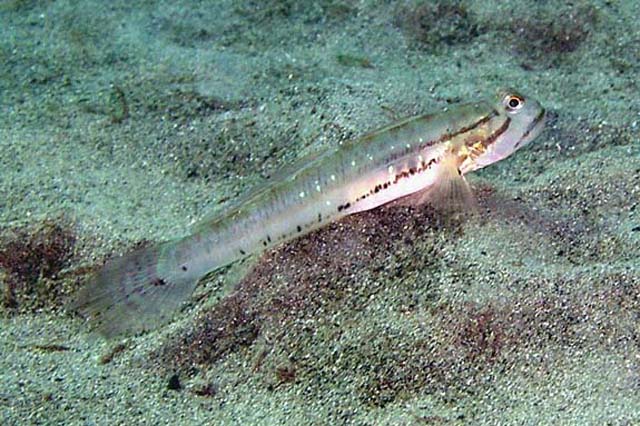| Gobiidae (Gobies), subfamily: Gobiinae |
| 7.6 cm SL (male/unsexed); 9.1 cm SL (female) |
|
demersal; brackish; marine; depth range 0 - 1 m |
| Indo-West Pacific: endemic to southern Australia. |
|
Dorsal spines (total): 7-7; Dorsal soft rays (total): 10-11; Anal spines: 1-1; Anal soft rays: 10-10. Distinguished by the following characters: body colour light brown; two oblique dark bands originating on head below eye, the upper degenerating into diffuse purplish brown blotches from the pectoral to caudal peduncle; black stripe arising at the pectoral insertion and running along lower body before breaking into small black spots above anal fin; dorsal fins with a horizontal dark band near the base; dark blue mark on membrane distally between first and second rays of D2; iridescent irregular blue blotches along flanks; three or more approximately vertical bands on upper caudal; vertebrae 10+15 (vertebral counts taken from radiograph); body cylindrical; snout blunt; eyes large, and close together dorsally; origin of pectorals under posterior margin of operculum; caudal oval and elongate; 7th pectoral ray extended into a filament; pelvics united into cup-shaped disc with branched rays; origin of pelvics covered by a loose sheath of skin; scales cycloid on belly and dorsally to second dorsal origin; posterior lateral scales peripheral ctenoid; head and predorsal region naked (Ref. 45534). |
| Found in muddy coastal areas to upper estuaries, rocky reefs, in sea grass beds and mangroves (Ref. 9002). |
|
Not Evaluated (N.E.) Ref. (130435)
|
| harmless |
Source and more info: www.fishbase.org. For personal, classroom, and other internal use only. Not for publication.
